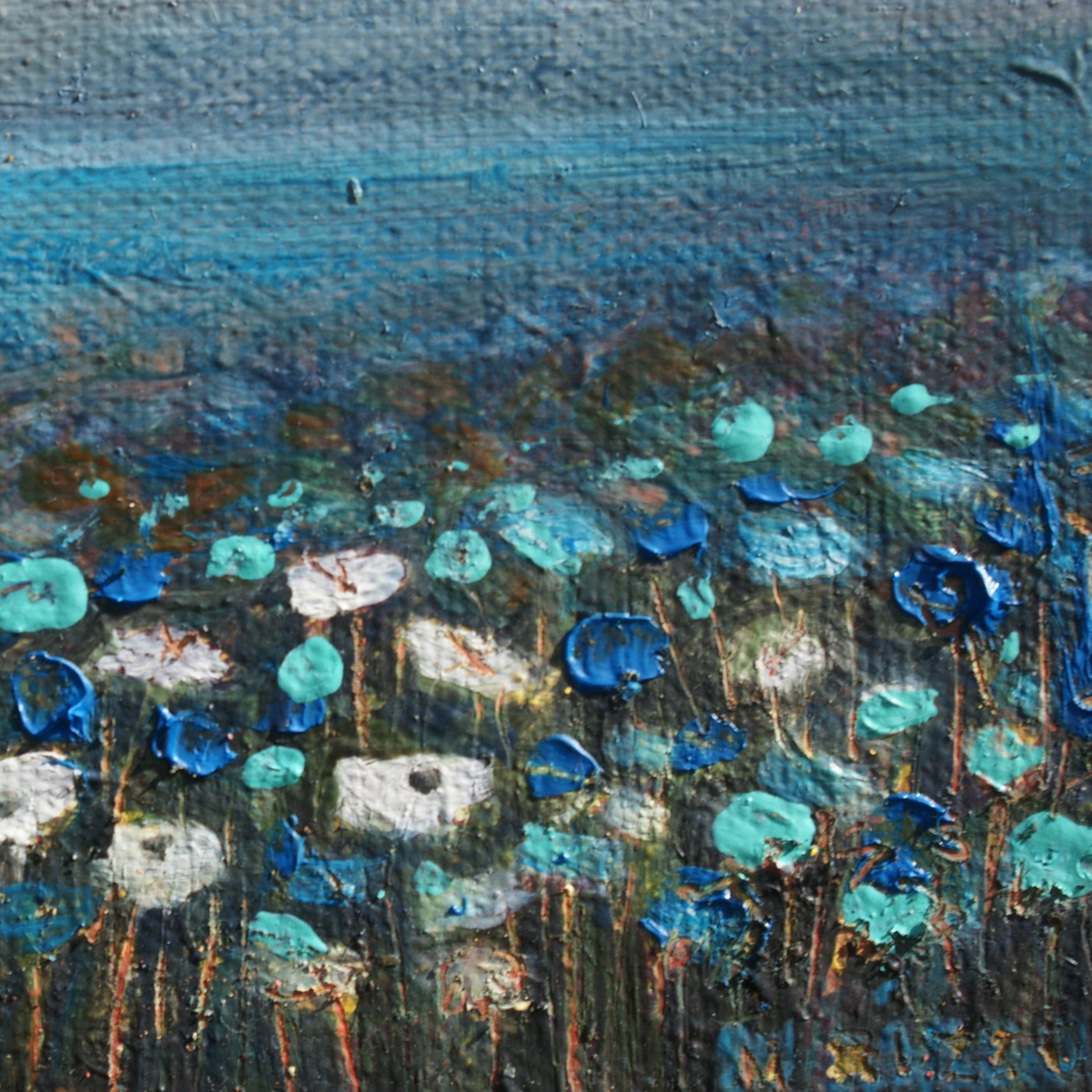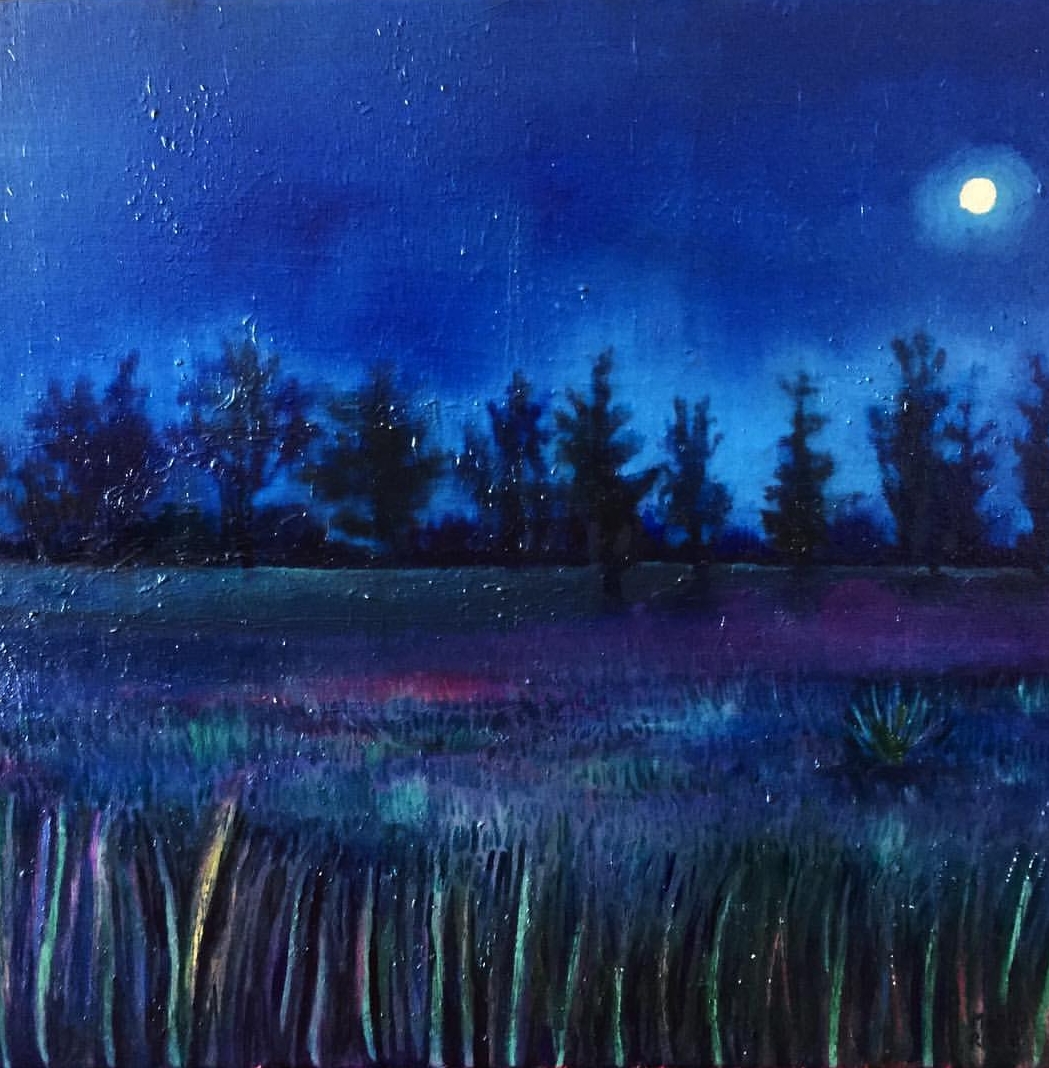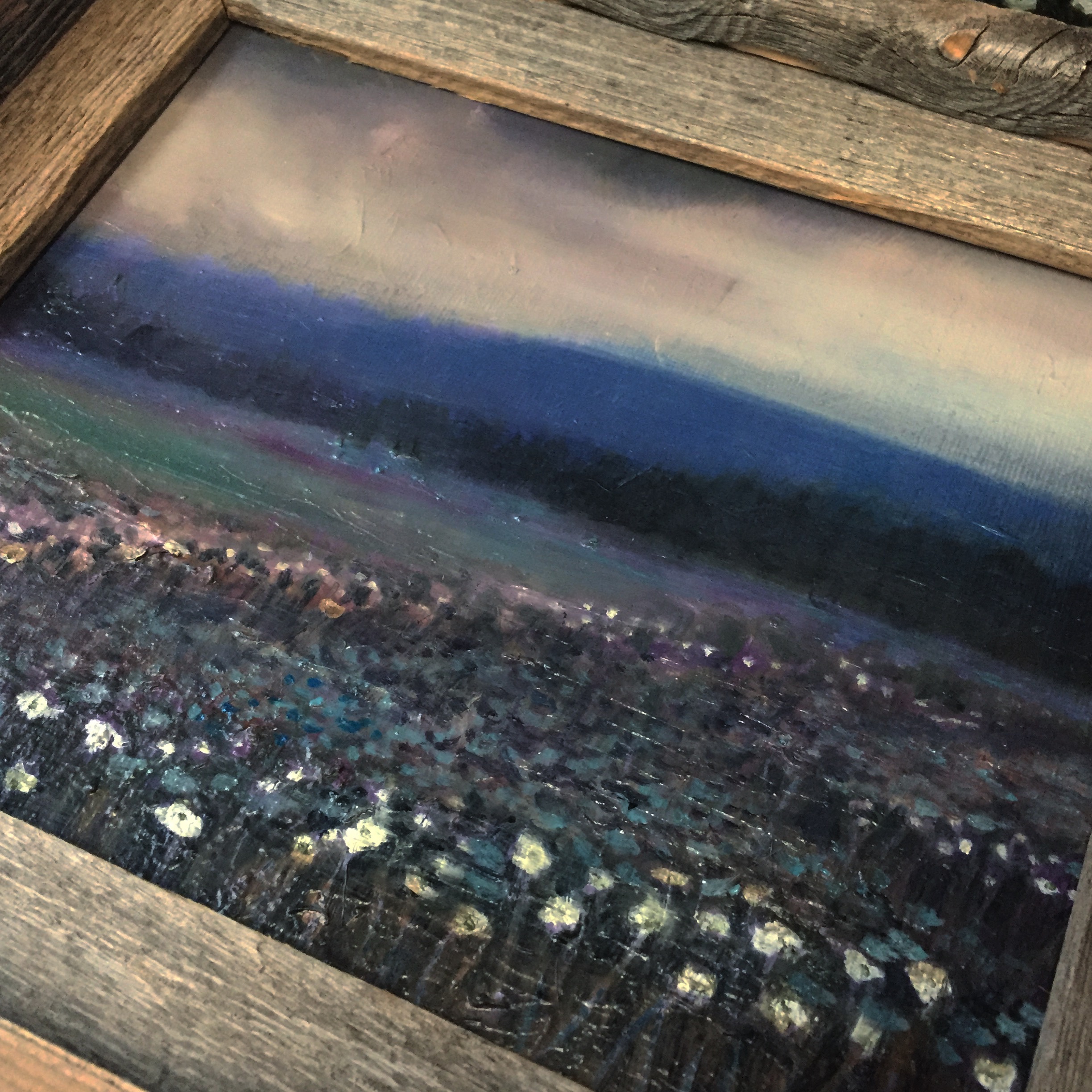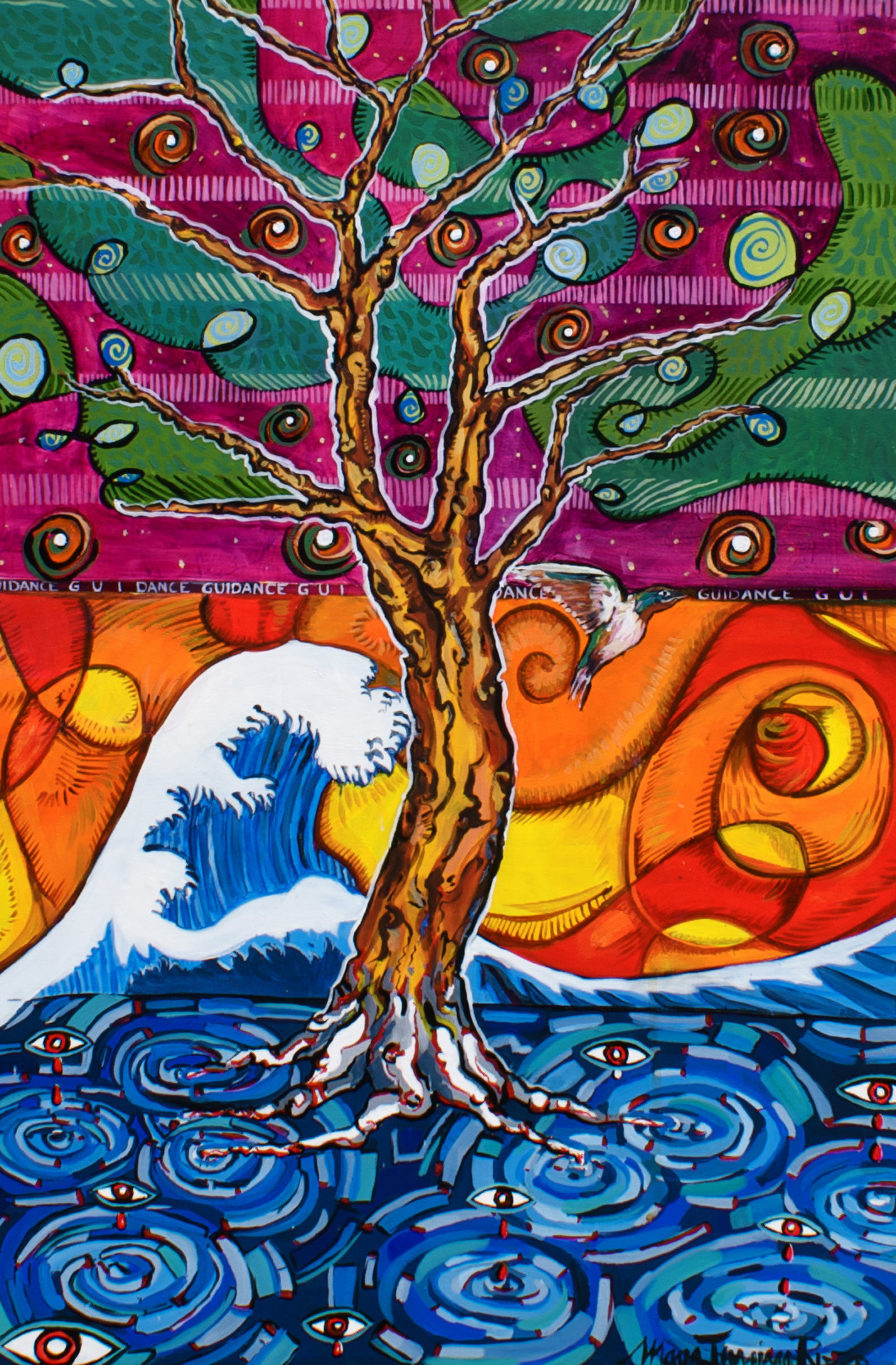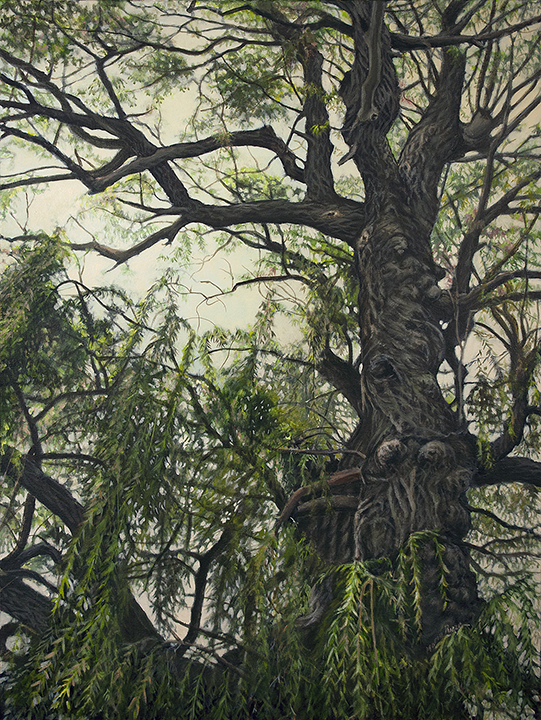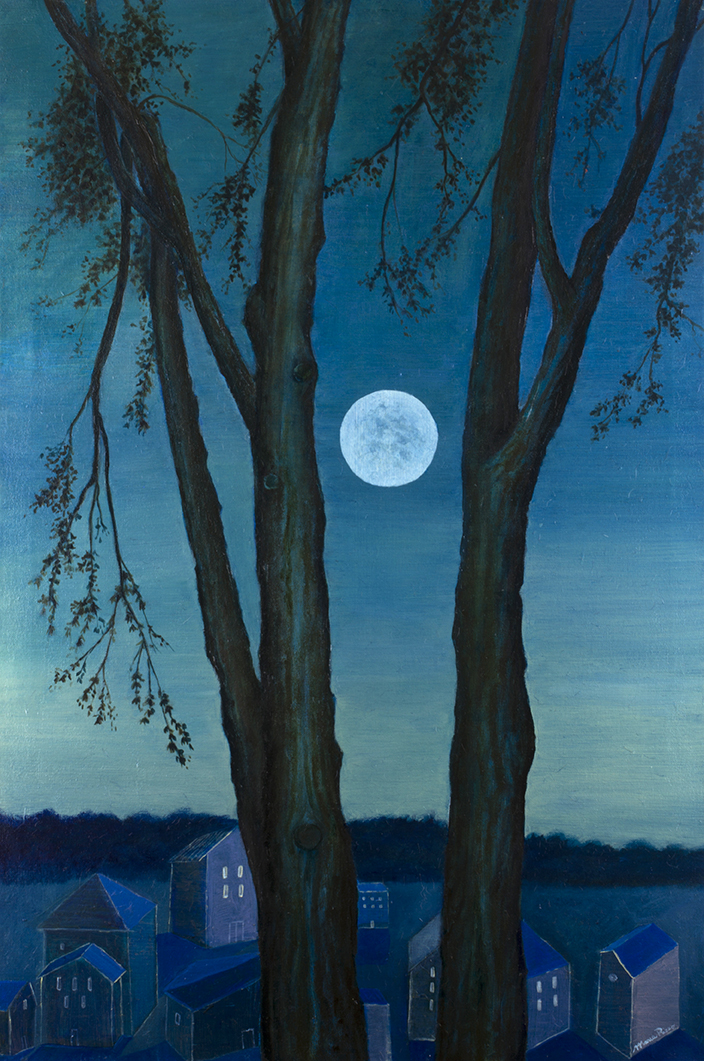VELATURA: An Exhibition and a New Art Collection
~ This April is going to be a special month. ~
The term velatura reflects my painting process, which consists of the fabrication, subtle layers upon layers of color, of dreamlike, and sometimes playful, realities.
My paintings are trees and nature scenes created as a response to those places that deeply resonate with me.
Although several paintings are copies from life; I adore creating art based from the real world yet vividly transformed by my infatuation for soothing colors like purples, greens, and blues.
I truly enjoy creating paintings that reflect my admiration for nature's creative force. With each brushstroke, I feel a connection with its whimsical energy.
~ This April is going to be a special month. ~
30 acrylic and oil paintings and sketches will be on view for Velatura: Creating Trees and Places with Subtle Layers of Purples, Greens, and Blues from April 1st to May 31st, 2017.
The opening reception will be held
on Tuesday, April 4, 2017
from 5:30pm to 7:30pm
at SUNY Empire State College
6333 Rte 298, 3rd floor
East Syracuse, NY (315-472-570)
Also, a new painting collection will be unveiled at Natur-Tyme, 3160 Erie Blvd. East, in DeWitt, NY, on April 1st! Here is a sneak peek preview:
I hope to see you at the opening reception. Come over and say hi, enjoy the refreshments, and celebrate with me five years of creativity, which is continually encouraged thanks to all of your amazing support.
Maria
How to Become a Happier (Fine) Artist
My big childhood dream was to become a professional fine artist – back then I had no concept of money; so, this dream came with no financial string attached. In 2009, I made the conscious decision to pursue my dream of becoming a professional artist, but, I made one big mistake. I decided that I needed to make money off my creativity.
My big childhood dream was to become a professional fine artist – back then I had no concept of money; so, this dream came with no financial string attached.
In 2009, I made the conscious decision to pursue my dream of becoming a professional artist, but, I made one big mistake. I decided that I needed to make money off my creativity.
This added expectation was the first step toward years of feeling unhappy as an artist. Every year, after doing my annual accounting, I felt like a failure because, no matter how much time I put into my art practice, I was not achieving the financial results I had hoped for.
The rule in business says you must create a product or a service to satisfy a need in the market; yet, I believe creatives find inspiration from within. When I started painting what I thought people would want, my art fell flat and I started experiencing several artist blocks.
Then I read Big Magic by Elisabeth Gilbert whose assertions gave me permission to think that as an artist, I should not expect to make money off my creativity. If it happens, great, but my life shouldn’t revolve around that goal. Artists should feel blessed that they have a talent and the courage to pursue their creative interests.
Elisabeth Gilbert, didn’t stop there, she also gave amazing advice on how artists can unblock their creativity. Gilbert agrees with Picasso who said that “inspiration exists, but it has to find us working,” yet, on top of carving time to be in the studio creating, she thinks that following our own curiosity, whatever that might be, is the secret for a life filled with continuous creative inspiration.
After reading Gilbert’s book, a giant weight was lifted from my shoulders. I felt free to be who I am without the pressure to make my bread and butter off my art. Although I do sell my paintings, prints, classes, etc., regularly, the amount I make every month doesn’t affect my self-worth as an artist because my attitude as shifted from a money-centered objective to the fulfillment of personal growth, which is one of my core values.
Looking back to the 7 years of painting and selling art and classes, my focus on making a living off my art was hiding the artistic and personal growth I was developing every year.
Color mixing in watercorol by Maria Rizzo.
That’s why artists that have another job are released by financial pressures, which is a burden that can undermine their creativity.
In conclusion, I believe that to become a happier (fine) artist, you need to make a long-term commitment to yourself to always carve out time for your art with a curious, experimental and free of judgement attitude.
As practice makes the master, I love how painter and fine art blogger, Lori McNee, answers people when asked “How long did it take to paint that?” She responds: “A lifetime, this painting took a lifetime to paint.”
Tips on How to Write an Effective Artist Statement
What I've realized, looking back to my 7 years running my creative business, is that my artist statement has been one of the most essential marketing tools I used to land opportunities to show my art, to win grants and awards, and to be published in articles and books. Click the link to learn how you can write a more effective artist statement.
If you are like me, you might have questioned why fine artists need an artist statement to show their art and, furthermore, you might wonder how do artists write an artist statement without sounding boring or uptight.
The Language of Trees at the Redhouse Art Center in Syracuse, NY, 2013. Curated by Marianne Dalton.
Yet, what I've realized, looking back to my 7 years running my creative business, is that my artist statement has been one of the most essential marketing tools I used to land opportunities to show my art, to win grants and awards, and to be published in articles and books.
Caroll Michell, the author of How to Survive and Prosper as an Artist, on the subject of the artist statement, writes:
An artist statement can be used as a tool to help dealers, art consultants, and advisors to sell your work, and as background information in helping writers, critics, and curators prepare articles, reviews, and exhibition catalogs. In addition, an artist statement can be incorporated into a cover letter..., on your Web site..., and into grant applications. (53)
Yet, Michell doesn't stop there as she gives some sound advice. The author writes:
An artist statement can focus on one or more topic, such as symbols and metaphors, materials and techniques, or themes or issues underlying or influencing your work. (53)
Maria Rizzo in front of the Onondaga Symbolic Tree, a community painting funded by the 2014 Individual Artist Grant from CNY Arts. Photo credits: Ray Trudell.
Another great piece of advice comes from Constance Smith, the author of Art Marketing 101. Smith asserts:
A correctly developed artist statement takes the reader to the heart of why you are an artist. It is a written dissertation of the idea behind your artwork, your personal philosophy -- the aim of your work. (139)
Here are some facts about the artist statement which I drew from Art Marketing 101:
It changes over time.
It's not the artist's life story.
It explains in words what the artist created in his or her art.
It is used by journalists, curators, art advisors, and art dealers to better understand the artist's work and to communicate his or her art philosophy to others.
It's used by the artist into as a copy for all his or her promotional materials.
It shouldn't be too long, a paragraph works.
It should be clear and simple.
- It should reflect your personality with the use of words that are meaningful to you.
Moody Trees II, oil on canvas by Maria Rizzo. Private Collector.
My artist statement has changed many times throughout the years. I have an upcoming senior exhibition scheduled for Tuesday, April 4, 2017 at SUNY Empire State College where I will showcase art I've created from 2012 to present so, I had to rewrite a new artist statement to better reflect my creative drive throughout the years. For marketing convenience, I also decided to write a longer artist statement for the art exhibition and a shorter one to use on all my promotional materials.
ARTIST STATEMENT
These paintings are trees and nature scenes created as a response to those places which deeply resonate with me. Although several paintings are copies from life; I adore creating art based from the real world but vividly transformed by my infatuation for soothing colors like purples, greens, and blues. I truly enjoy creating paintings that reflect my admiration for nature's creative force. With each brushstroke, I feel a connection with its whimsical energy.
My approach to painting depends on the complexity of the subject. For example, when I create paintings based from life, I make a pencil sketch first, which I transfer on canvas. Next, I use a monochromatic pittura del fondo to establish the chiaro scuro: the light and dark values of the composition. Once the underpainting is finished, I add the velatura, glazes of color, that add to the realism of the painting. When I paint evocative nature scenes, I play with blue-brown washes and bold, bright marks which slowly morph into a suggestive landscape. This creative process begins with a dynamic abstraction and ends into a believable, yet personal, reality.
Like sailing, my creativity is fueled by dedication and perseverance; yet, it is curiosity that allows me to explore its vastness, and grow as an artist.
SHORT ARTIST STATEMENT
My paintings are peculiar trees and evocative nature scenes created as a response to those places which beauty deeply resonated with me. Although several paintings are copies from life; I adore creating art which might be based from the real world but then is vividly transformed by my infatuation for evocative, yet soothing, colors like purples, greens, and blues. I truly enjoy creating paintings that reflect my admiration for nature's creative force as, with each brushstroke, I feel a connection with its whimsical energy. Throughout my creative journey, my drive to paint comes from a desire to express the devotion I feel for nature and my relationship to it.
I hope this blog post will inspire you to write or update your artist statement!
Until next time,
Maria R.
10 Tips to Grow as a Visual Artist
When I was 22 years old, I decided to start a part-time business as a professional painter and my goal for that year was to create a painting’s series because I was told by an established artist, and by many art marketing books, it was the way to be represented by an art gallery. So, I did. I spent the whole year of 2010 creating my first body of work and that was the beginning of my creative venture. But how exactly do you grow as a visual artist? Here are 10 tips that have contributed to my growth as a two-dimensional visual artist.
Detail of Pink Flowers by Maria Rizzo
When I was 22 years old, I decided to start a part-time business as a professional painter and my goal for that year was to create a painting’s series as I was told by an established artist, and by many art marketing books, it was the way to be represented by an art gallery.
So, I did. I spent the whole year of 2010 creating my first body of work and that was the beginning of my creative venture.
Did I land into a commercial art gallery?
Not really.
What I wasn’t told then is that when you start out as an artist, your art is not that good; yet, it is CRUCIAL for you to start somewhere!
My 7 years’ younger self did the best she could do and, if I did let personal fears and other people’s negative opinions stop me then, I could not create the way I do today.
But how exactly do you grow as a visual artist?
Here are 10 tips that have contributed to my growth as a two-dimensional visual artist.
Study of Pears by Maria Rizzo
1) Just create. Don’t let perfectionism and fear stop you from even beginning your creative journey. Be kind to yourself as practice makes the master!
2) Learn the foundations. For any art discipline, to become good at it, you first need to learn the basics. Picasso once said “Learn the rules like a pro, so you can break them like an artist.” For visual artists learning to draw, color theory, and color mixing are crucial for their own long-term artistic success.
3) Learn to attentively observe. Keeping an art journal and sketching what catches your attention is a great way to further develop your eye/hand coordination and technique. A lot of famous artists, along with their sketches, wrote down notes about the colors and other details they observed while drawing their subject matter. This habit allowed these artists to recreate a more developed painting back in their studio, without missing out the important details they experienced while sketching from life. There is nothing wrong in taking a photo as a reference; yet, the point is not to just copy a photo but to put your feelings and experience into your final piece!
Painting tools with a flower field study in oil by Maria Rizzo.
4) Master your tools. In my experience, learning all I could about my art materials and tools was crucial for creating faster. Observing how other professional artists work is truly educational and illuminating. There are many art video tutorials that you can check for free online or think about investing into a local art class by an artist whose work you admire.
5) Go to art museums. My favorite teacher-artist became an exceptional painter by reproducing the art painted by the masters. Thus, reproducing other famous artists’ artwork is a great way to learn about composition, use of color and technique.
6) Stick with one medium. Chose a medium of your liking and master it. Once you are great at it, invest your time into another medium and master that one, as well. Don’t stop there, take the time to use new materials so that in the future you can experiment and find your voice.
Detail of Moody Trees III, oil on canvas by Maria Rizzo, 2017.
7) Take art classes. I’ve spent 5 years mastering acrylic painting until I decided to overcome my fear of oil painting by taking a class with an amazing local artist who paints like the old masters. Learning the basics and steps to create a successful painting from him gave me the confidence necessary to further grow as an artist.
8) Show your art and listen to people’s response. Since 2010, I have shown my art at local art guilds, online art groups, alternative spaces, non-profit galleries, art centers, and museums. Even though it’s always nice to hear positive feedback, what truly made me grow as an artist was receiving constructive criticism which ignited a personal desire to improve my technique, my composition and overall approach to painting.
Flower-field at Night, 8x10' oil on canvas by Maria Rizzo, 2017.
9) Listen to criticism with a grain of salt. Not all criticism is good. In the world, there are always rude people who love to share their misery with the rest of us. These people are not worth your time or energy; thus, do not listen to them, be the bigger person and move on.
10) Don’t compare yourself to other artists. There is nothing more depressing than comparing your art with the artwork made by others. What I’ve learned so far is that it’s way more constructive and realistic to compare my art to the art I created years ago.
Wow!
It’s amazing to visually see the growth I made as an artist through many years of hard work, curiosity, and perseverance. Furthermore, I look forward to see where this creative path will bring me 10 years from now, and yours!
Maria R.
MARIA RIZZO
Trees, Lands & Dreams | Art Blogger #theartistspath | Art Educator | From Italy 🇮🇹🇺🇸 |





